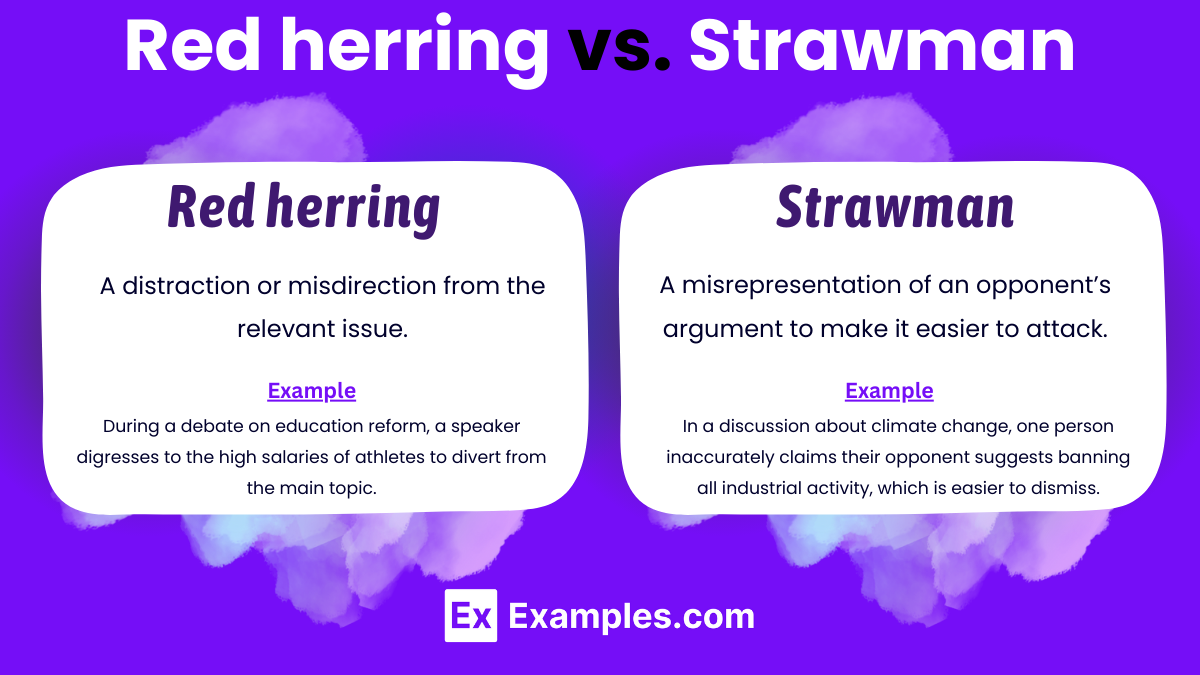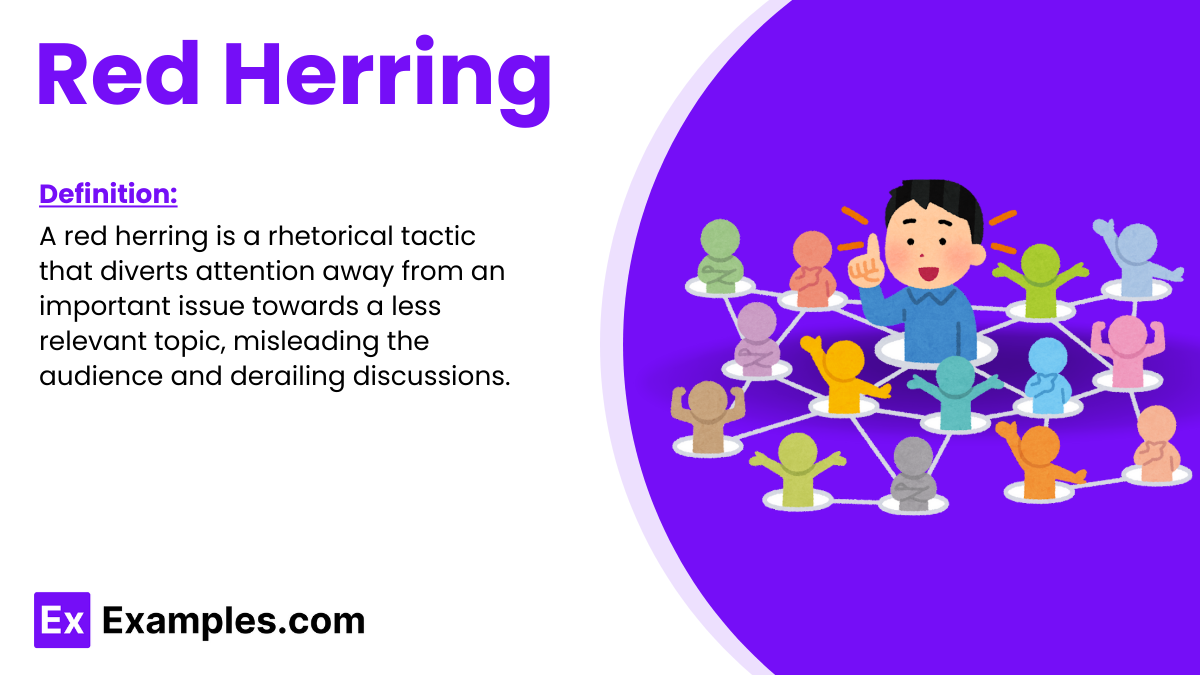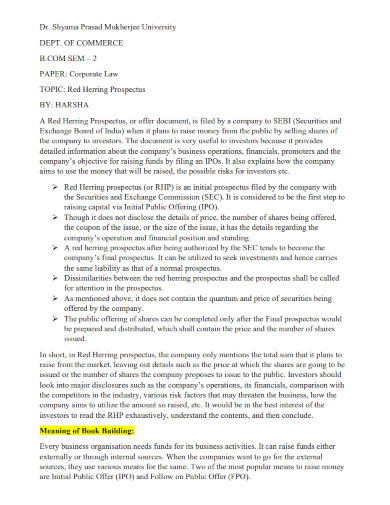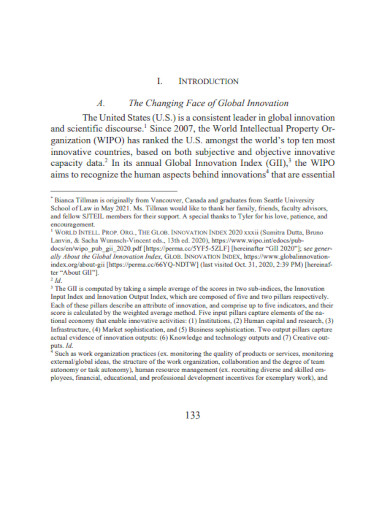Red Herring – Examples, PDF
Red herring is a term often used in discussions surrounding logic, literature, and everyday conversation to describe something that misleads or distracts from the relevant or important issue. It refers to any diversion that leads people away from the topic at hand or prevents them from reaching a conclusion or decision.
What is a Red Herring ?
A red herring is a misleading clue or distraction that diverts attention from the main issue. Originally stemming from a technique to mislead hunting dogs using a smoked fish’s scent, the term now broadly applies to deceptive tactics in arguments, stories, or investigations that lead audiences away from the truth or relevant points.
Techniques of Red Herring
Red herrings are deliberate attempts to divert attention from the main issue or argument. Here are some common techniques used to employ red herrings in various contexts:
1. Irrelevant Information
- Introducing facts or figures that, while interesting, do not pertain to the main argument or topic. This can confuse or sidetrack the audience from the issue at hand.
2. Changing the Subject
- Abruptly changing the topic to avoid confrontation or deeper discussion on a challenging subject. This technique shifts the conversation away from the original point.
3. Ad Hominem Attacks
- Attacking the opponent’s character or personal traits instead of engaging with their arguments. This tactic diverts attention by focusing the discussion on the individual rather than the issue.
4. Appeal to Emotion
- Using emotional appeals that are unrelated to the argument’s logic to sway the opinion of others. This can involve evoking fear, pity, or excitement as a distraction.
5. Overwhelming with Details
- Providing an excessive amount of detail to overwhelm the audience, making it difficult to focus on the main argument or issue.
6. Straw Man Argument
- Misrepresenting an opponent’s argument to easily attack or refute it, rather than dealing with the actual argument presented.
7. Appeal to Authority
- Citing an authority figure or expert in an unrelated field to bolster an argument, which diverts the discussion from its original focus.
Red herring vs. Strawman

| Aspect | Red Herring | Straw Man |
|---|---|---|
| Definition | A distraction or misdirection from the relevant issue. | A misrepresentation of an opponent’s argument to make it easier to attack. |
| Purpose | To divert attention from the original topic to avoid addressing the main issue. | To simplify or distort the opposing argument to refute it more easily. |
| Technique | Introducing irrelevant information, changing the subject, or using emotional appeals. | Misrepresenting or exaggerating an opponent’s position. |
| Outcome | The original issue remains unaddressed or unresolved. | The real argument is not addressed, focusing instead on the distorted version. |
| Example | During a debate on education reform, a speaker digresses to the high salaries of athletes to divert from the main topic. | In a discussion about climate change, one person inaccurately claims their opponent suggests banning all industrial activity, which is easier to dismiss. |
Examples of Red Herring in Real life
Red herrings are commonly used to mislead or distract from the central issue. Here are ten real-life examples of how red herrings might appear:
1. Political Debates
- A politician being questioned about an economic policy might start discussing a completely unrelated impressive achievement from their term to avoid addressing the question.
2. Sales Pitches
- A salesperson highlighting the popularity of a product rather than responding to concerns about its safety or side effects.
3. Media Reporting
- News stories emphasizing minor details of a larger scandal to draw attention away from the core issues of corruption.
4. Job Interviews
- A candidate, when asked about a specific gap in employment, talks extensively about their volunteer experience instead of addressing the gap.
5. Academic Discussions
- A student, when unable to answer a question about the subject matter, diverts the conversation to a loosely related topic they know better.
6. Legal Defense
- In a court case, a defense attorney emphasizes a minor inconsistency in the prosecution’s case to distract from the overwhelming evidence against their client.
7. Marketing
- An advertisement focusing on the sustainability of packaging rather than the poor quality of the product inside.
8. Customer Service
- A customer service representative dwells on the benefits of a warranty policy instead of addressing a complaint about a defective product.
9. Family Arguments
- During a dispute about overspending, one person brings up an unrelated incident to shift the blame or guilt.
10. Education Policy Discussions
- In a discussion about improving education standards, an official brings up budget allocations to other departments, steering the conversation away from educational issues.
Examples of Red Herring in Movies
Red herrings are a popular narrative device in films, especially in the mystery and thriller genres, where they are used to mislead the audience and build suspense. Here are some examples of red herrings in movies:
1. “Psycho” (1960)
- The early scenes focus on Marion Crane stealing money, leading viewers to believe the plot will center around her attempts to escape with the cash. However, her unexpected murder shifts the entire direction of the film.
2. “The Sixth Sense” (1999)
- Throughout the movie, the focus on Cole’s ability to see ghosts leads viewers away from the truth about Dr. Malcolm Crowe’s own reality, setting up one of cinema’s most famous twists.
3. “Gone Girl” (2014)
- Nick’s suspicious behaviors and the discovery of his affair initially lead the audience to believe he may be responsible for his wife’s disappearance, which is a deliberate misdirection from the actual plot twist.
4. “Scream” (1996)
- The movie uses red herrings to mislead viewers about the identity of the killer, with various characters being set up with motives and opportunities, keeping the audience guessing until the end.
5. “The Prestige” (2006)
- The intense rivalry and obvious sabotage between the two magicians serve to distract viewers from the true secrets behind their magic tricks.
6. “Mystic River” (2003)
- The film leads viewers to suspect Dave because of his strange behavior following the murder of Jimmy’s daughter, diverting attention from the real killer.
7. “Fight Club” (1999)
- The dynamics between the narrator and Tyler Durden focus heavily on their individual characters and actions, steering the audience away from the truth of their connection.
8. “Se7en” (1995)
- The focus on the serial killer’s motives and methodology draws attention away from the climactic twist involving Detective Mills’ personal life.
9. “Clue” (1985)
- This movie, based on the board game, uses multiple red herrings to suggest various characters as the murderer, aligning with the game’s mechanics of misleading the players.
10. “Knives Out” (2019)
- Various family members are presented with motives and suspicious behaviors, creating multiple red herrings that mislead both the characters and the audience about who is responsible for the patriarch’s death.
Examples of Red Herring in Sentences
Red herrings in sentences often serve to distract from the main point or issue being discussed. Here are examples of how red herrings can be used in sentences to shift focus or mislead:
1. During the Debate
- “While we’re discussing the need for healthcare reform, let’s not forget how well our sports teams are performing this season.”
2. In a Meeting
- “Yes, the project is behind schedule, but remember how many challenges we’ve already overcome to get this far.”
3. In a Political Discussion
- “We can talk about political corruption, but what about all the good things the government has done for infrastructure?”
4. During an Argument
- “I know I forgot our anniversary, but think about all the times I’ve made dinner for you last month.”
5. In a Sales Pitch
- “You’re concerned about the safety of this car, but can we talk about how luxurious the interior is?”
6. In a News Article
- “Though there are allegations of embezzlement, the CEO has increased company profits significantly over the past year.”
7. In a Classroom Discussion
- “I understand your question about the historical inaccuracies in the textbook, but how amazing is it that we have such diverse sources to learn from?”
8. In Customer Service
- “You’re upset about the delay in shipment, but did you notice the 20% discount we included in your last purchase?”
9. In a Family Dispute
- “We may not agree on how to handle finances, but let’s focus on planning our upcoming vacation instead.”
10. During a Policy Review
- “There may be issues with the current policy, but let’s take a moment to appreciate how far we’ve come from the old regulations.”
1. Draft Red Herring Prospectus
2. Book Building and Red Herring Prospectus
3. Red Herring After Cardiac Surgery
4. Red Scare Red Herring Example
Examples Red Herring in literature
Red herrings are a staple in literature, especially in mystery and suspense genres, where they serve to mislead readers and add complexity to the plot. Here are some notable examples of red herrings used in literary works:
1. “The Hound of the Baskervilles” by Sir Arthur Conan Doyle
- Doyle uses the legend of a supernatural hound and several suspicious characters to mislead readers about the true nature of Sir Charles Baskerville’s death.
2. “And Then There Were None” by Agatha Christie
- Christie masterfully deploys numerous red herrings, with characters behaving suspiciously and misleading clues scattered throughout, which distract from identifying the real killer until the very end.
3. “Gone Girl” by Gillian Flynn
- Flynn constructs a narrative filled with misleading clues that suggest the protagonist, Nick, might be responsible for his wife’s disappearance, diverting attention from the true circumstances.
4. “The Girl with the Dragon Tattoo” by Stieg Larsson
- Various misleading clues and suspects are presented to shift the reader’s focus away from the real villain in the mystery of Harriet Vanger’s disappearance.
5. “The Da Vinci Code” by Dan Brown
- Brown introduces various puzzles and codes that seem to lead to the Holy Grail, but these clues often mislead both the characters and the readers, obscuring the true secret.
6. “Murder on the Orient Express” by Agatha Christie
- Christie uses the alibis and interwoven stories of each passenger to divert attention from the collective guilt shared by all involved.
7. “The Big Sleep” by Raymond Chandler
- Chandler throws numerous plot twists and character actions into the narrative that seem crucial but ultimately do not affect the resolution of the main mystery.
8. “Harry Potter and the Goblet of Fire” by J.K. Rowling
- Throughout the novel, Mad-Eye Moody is positioned as a mentor to Harry, but his odd behavior occasionally hints at something more sinister, misleading the reader about his true identity.
9. “The Westing Game” by Ellen Raskin
- The novel is filled with false leads and misleading clues that keep the characters and readers guessing who is behind the mysterious legacy of Sam Westing.
10. “The Secret History” by Donna Tartt
- Tartt plants various suggestions about the reasons and dynamics behind a murder among a group of college students, misleading readers about the true motives and relationships until the end.
Examples Red Herring in Politics
Red herrings are distractions or diversions from the main issue in a debate or discussion. Politicians often use them to avoid answering difficult questions or to shift the focus to topics where they feel more comfortable. Here are ten easy-to-understand examples of how red herrings appear in political discourse:
1. Economic Questions to Defense Issues
- Example: A politician is asked about their plans to tackle inflation but instead talks about increasing military spending to ensure national security.
2. Scandal Deflection to Public Achievements
- Example: Faced with questions about a recent misconduct, a politician begins to highlight their role in passing popular legislation.
3. Environmental Concerns to Economic Growth
- Example: When questioned about their weak environmental policies, a politician diverts to talking about how their policies have boosted the economy.
4. Healthcare System Queries to Immigration
- Example: Instead of addressing issues in the healthcare system, a politician shifts the conversation to the need for stricter immigration laws.
5. Education Funding to Tax Cuts
- Example: A politician dodges questions about cutting education funding by discussing how their tax cuts have benefited the middle class.
6. Unemployment Rates to Technological Advancements
- Example: When asked about rising unemployment rates, a politician steers the discussion toward the country’s advancements in technology.
7. Housing Crisis to Foreign Policy
- Example: Instead of tackling questions about the housing crisis, a politician talks about their successful foreign policy to divert attention.
8. Social Inequality to National Pride Events
- Example: Faced with questions about social inequality, a politician changes the topic to upcoming national celebrations and unity events.
9. Corruption Allegations to Infrastructure Projects
- Example: To avoid discussing corruption allegations, a politician enthusiastically outlines new infrastructure projects.
10. Public Health Concerns to Sports Achievements
- Example: Asked about public health concerns, a politician shifts focus to the country’s recent international sports achievements.
How to Use Red Herring
Red herring is a technique and a tool made to confuse or to mislead someone from the truth. There are a lot of ways that a red herring is used. But the main way to use them is through stories like writing articles, mystery, and even through the press.
Step 1: Red Herring in a Sentence
Did you know you can also write a red herring in a sentence? It is quite easy to add a simple red herring to your sentence by placing false information or redirecting it to something else. An example of this would be a mother telling her daughter or her son that there is food at home, when the child is asking for a toy.
Step 2: Red Herring in Stories
Authors love a good mystery and would often add red herrings to make their stories even more interesting. Most authors use red herrings for their antagonists to confuse their readers, or to mislead their readers into assuming anything within the story.
Step 3: Essays and Speeches
When it comes to writing essays or speeches, using a red herring in it will also make your listeners and audience think whether or not the writing is connected to the topic or not. For those who have experienced red herrings in speeches will be able to identify the misleading information over the correct information.
Step 4: The Use of Red Herrings in Important Topics
A variety of people may use unrelated information in important topics. This is a way they use to hide the truth or to hide the facts from everyone. A lot of people who may not be able to figure out the red herring in topics will believe this is the fact rather than false information.
FAQs
Where does the term red herring come from?
The term red herring was once coined by a man named William Cobbett in 1807. He coined the word as a means to explain that the red herring was a kind of fish when baked and dried in the sun would give off a distinctive smell that could confuse hunting dogs who are in search of smaller prey. William Cobbett stated that anyone who was able to smell that fishy smell was misled or confused as to what they were seeking to begin with.
How can you answer a red herring question?
In order for you to distinguish between the truth and a red herring answer, the simplest way is to ask the person to explain their answer or their question. Explain, find the logic in it and to redirect it to the original question and original answer. This helps by discussing and accepting the facts and moving on.
Why do people use red herrings?
People use these for a variety of reasons. For writers, it makes their characters sound interesting and it can also give their characters an edge. For some, it is a way to avoid answering the question or avoid answering the truth. Red herring can be seen in a positive light and in a negative light.
Understanding the use and the origins of red herring will help you see if the person is trying to mislead you to the truth. Understanding how a red herring also works will help you figure out how to answer a red herring question or red herring answer. It is a little bit difficult at first, but with practice, you are able to see through the curveball and find out the truth.






